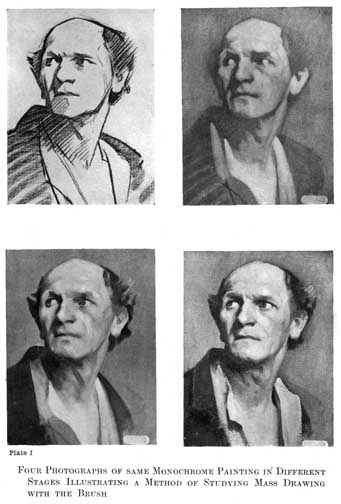THE
PRACTICE & SCIENCE
OF
DRAWING
BY
HAROLD SPEED
Associé de la Société Nationale desBeaux-Arts, Paris; Member of the Royal Society of PortraitPainters, &c.
With 93 Illustrations & Diagrams
LONDON
SEELEY, SERVICE & CO. LIMITED
38 GREAT RUSSELL STREET
1913

Plate I.
FOUR PHOTOGRAPHS OF SAME MONOCHROME PAINTING IN DIFFERENT STAGESILLUSTRATING A METHOD OF STUDYING MASS DRAWING WITH THE BRUSH
v
PREFACE
Permit me in the first place to anticipate the disappointment ofany student who opens this book with the idea of finding "wrinkles"on how to draw faces, trees, clouds, or what not, short cuts toexcellence in drawing, or any of the tricks so popular with thedrawing masters of our grandmothers and still dearly loved by alarge number of people. No good can come of such methods, for thereare no short cuts to excellence. But help of a very practical kindit is the aim of the following pages to give; although it may benecessary to make a greater call upon the intelligence of thestudent than these Victorian methods attempted.
It was not until some time after having passed through thecourse of training in two of our chief schools of art that theauthor got any idea of what drawing really meant. What was taughtwas the faithful copying of a series of objects, beginning with thesimplest forms, such as cubes, cones, cylinders, &c. (anexcellent system to begin with at present in danger of someneglect), after which more complicated objects in plaster of Pariswere attempted, and finally copies of the human head and figureposed in suspended animation and supported by blocks, &c. In sofar as this was accurately done, all this mechanical training ofeye and hand was excellent; but it was not enough. And when with aneye trained to the closest mechanical viaccuracy the authorvisited the galleries of the Continent and studied the drawings ofthe old masters, it soon became apparent that either his or theirideas of drawing were all wrong. Very few drawings could be foundsufficiently "like the model" to obtain the prize at either of thegreat schools he had attended. Luckily there was just enoughmodesty left for him to realise that possibly they were in somemysterious way right and his own training in some way lacking. Andso he set to work to try and climb the long uphill road thatseparates mechanically accurate drawing from artistically accuratedrawing.
Now this journey should have been commenced much earlier, andperhaps it was due to his own stupidity that it was not; but it waswith a vague idea of saving some students from suchwrong-headedness, and possibly straightening out some of the path,that he accepted the invitation to write this book.
In writing upon any matter of experience, such as art, thepossibilities of misunderstanding are enormous, and one shudders tothink of the things that may be put down to one's credit, owing tosuch misunderstandings. It is like writing about the taste ofsugar, you are only likely to be understood by those who havealready experienced the flavour; by those who have not, the wildestinterpretation will be put upon y